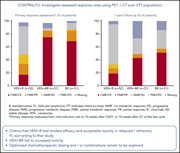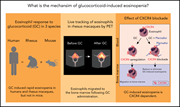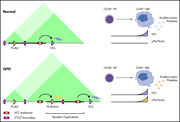Issue Archive
Table of Contents
BLOOD COMMENTARIES
PLENARY PAPER
Bone marrow regeneration requires mitochondrial transfer from donor Cx43-expressing hematopoietic progenitors to stroma
The exchange of mitochondria between intimately connected cells of different types that function collaboratively is an area of intense scientific interest. Golan and colleagues used elegant murine models to show how transfer of mitochondria from transplanted hematopoietic stem and progenitor cells (HSPCs) to bone marrow mesenchymal stem cells (MSCs) occurs. Healthy donor HSPCs not only reconstitute the hematopoietic system after transplantation but also support and induce the metabolic recovery of their irradiated, damaged MSCs via mitochondria transfer.
REVIEW ARTICLE
Management of AL amyloidosis in 2020
New drugs are emerging as treatment options for patients with light-chain (AL) amyloidosis. In this timely review, Palladini et al first remind us of the importance of ensuring a precise diagnosis and then discuss a framework for care of newly diagnosed patients and those with relapsed or refractory disease.
CLINICAL TRIALS AND OBSERVATIONS
Venetoclax-rituximab with or without bendamustine vs bendamustine-rituximab in relapsed/refractory follicular lymphoma
Clinical Trials & Observations
Zinzani et al report the results of the open-label, randomized phase 2 CONTRALTO study, which evaluated addition of the BCL-2 inhibitor venetoclax to bendamustine plus rituximab in patients with relapsed/refractory follicular lymphoma. Despite the prominence of BCL-2 in the pathophysiology of follicular lymphoma, no meaningful efficacy benefit was observed and toxicity was increased. This negative trial has implications for how BCL-2 inhibitors are investigated in treatment regimens for follicular lymphoma.
IMMUNOBIOLOGY AND IMMUNOTHERAPY
Extended clinical and immunological phenotype and transplant outcome in CD27 and CD70 deficiency
Ghosh et al report the clinical spectrum of rare patients with deficiencies of either CD27 or CD70, the components of a receptor-ligand pair pivotal to the immunological control of Epstein-Barr virus. As well as virus-mediated immune dysregulation and autoinflammation, there is a marked predisposition to lymphoma. Patients can have excellent outcomes with allogeneic transplants.
LYMPHOID NEOPLASIA
Monoclonal immunoglobulins promote bone loss in multiple myeloma
Bone disease in multiple myeloma is a serious clinical problem. Westhrin and colleagues present novel data that demonstrate a causative role for monoclonal immunoglobulins in promoting osteoclast differentiation and bone loss in patients with myeloma. These data help explain why bone loss is such a common feature in these patients and may lead to new therapeutic options.
PHAGOCYTES, GRANULOCYTES, AND MYELOPOIESIS
Glucocorticoid-induced eosinopenia results from CXCR4-dependent bone marrow migration
Glucocorticoids have been used for decades for hypereosinophilic disorders. Eosinopenia occurs within a few hours, but the molecular mechanisms behind the disappearance of eosinophils from blood circulation are poorly defined. Hong et al demonstrate that in macaques in vivo, rapid glucocorticoid-induced, CXCR4-mediated eosinophil homing to the bone marrow occurs, thereby explaining, at least in part, the clinical phenomenon.
PLATELETS AND THROMBOPOIESIS
Enhancer-gene rewiring in the pathogenesis of Quebec platelet disorder
Quebec platelet disorder is manifested by >100-fold–increased platelet stores of urokinase plasminogen activator (PLAU/uPA) and bleeding due to platelet-dependent, accelerated fibrinolysis. Liang and colleagues reveal that the causative 78-kb tandem duplication in the PLAU gene results in such massive upregulation of protein production through ectopic association of the tandem duplication with a megakaryocyte enhancer and loss of epigenetic silencing.
RED CELLS, IRON, AND ERYTHROPOIESIS
NCOA4 is regulated by HIF and mediates mobilization of murine hepatic iron stores after blood loss
Nuclear receptor coactivator 4 (NCOA4) was first identified as an autophagic receptor for ferritin with a capacity to direct ferritin into autophagosomes destined for destruction in the lysosome. Now, Li et al show that NCOA4 is required to mobilize the iron stored in hepatocyte ferritin for stress erythropoiesis, for example, after acute blood loss. Their work also suggests a new mode of iron-dependent transcriptional regulation for NCOA4 that involves hypoxia-inducible factors 1 and 2 (HIF-1 and -2).
THROMBOSIS AND HEMOSTASIS
LETTER TO BLOOD
Geriatric assessment and survival among older adults receiving postremission therapy for acute myeloid leukemia
Clinical Trials & Observations
BLOOD WORK
-
Cover Image
Cover Image
![issue cover]()
Mitochondrial distribution and volume in an isolated murine bone marrow mesenchymal stromal cell. Colors depict increasing volume in a red shift scale (blue-green-yellow). See the article by Golan et al on page 2607.
- PDF Icon Front MatterFront Matter
- PDF Icon Table of ContentsTable of Contents
- PDF Icon Editorial BoardEditorial Board
Advertisement intended for health care professionals
Email alerts
Advertisement intended for health care professionals












HSCs revive their niche after transplantation